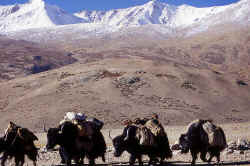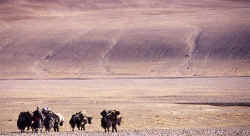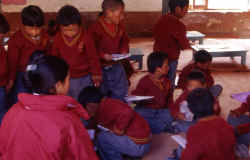MyHimalayasimpressions from |
|
|||||||

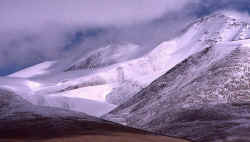
Unnamed, unclimbed (???) peak near Sharma camp, an attempt to climb had to be abandoned
due to bad weather.
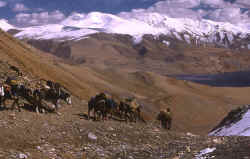
The caravan descending from Yalung Nyam Lao towards to Tso
Moriri.
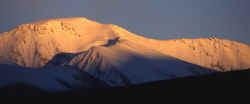
Sunset on a peak across the lake. The summer before two trekkers died during the ascent of
the 6'666 m peak; they froze to death when bad weather moved in.
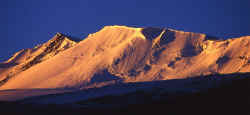
Near Karzok I experienced one of the few classical sunrise scenes during the trek. The sun
rises over the distance mountain range that forms the horizon and puts the Mentok
range into a orange light.
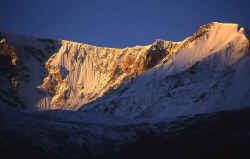
Another peak of the Mentok range.
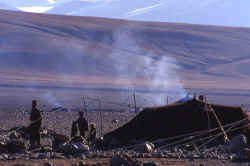
Traditional yak wool tent of the nomads.
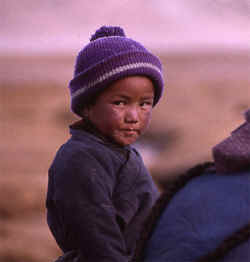
The nomad kids near Karzok have not been spoiled by tourists offering pens or sweets.
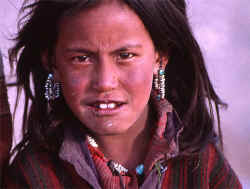
Wild young nomad daughter, nevertheless she ran off when our jeep arrived.
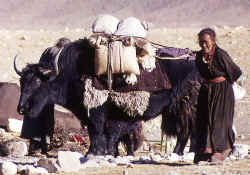
Yaks are being loaded with goods that are sold or traded in a nearby settlement.
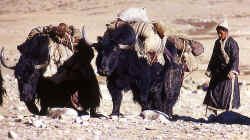
Nomad with his yaks sets out for trading wool.
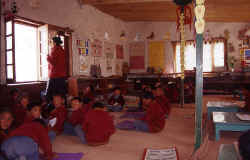
Tibetan Children Village school in Sumdo.
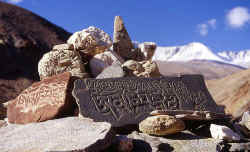
On the way from the nomads' tents to Karzok we pass wonderfully carved mani stones.
Tso Moriri: Sharma - Tso Moriri - Leh
Sharma - Tso Moriri - Leh
Sharma Rest day (Day 18)
My plan was to walk up the scree slope of an adjacent peak, probably above 6'000 meters but technically just a stroll. When I open the tent early before sunrise it's very cold, and fog lingers around, so my early departure is postponed until sunrise. The good thing about being alone in camp is that you get little treats like large amounts of hot water, and special breakfast: hot noodle soup and a grilled cheese sandwich. Malc is also up, we set out for a short walk towards the glacier. Actually he just wanted to go a short way to the grazing horses, his altitude sickness is still there though less severe. It's a very pleasant walk, and we continue towards the mountain that the others are climbing. The weather gets worse. The peak I originally wanted to climb is completely covered in mist and I won't even attempt it. A little hill seems a worthwhile alternative, once we get halfway up the weather turns really bad. We're at the altitude of the glacier, below us the frozen glacial pond that seem characteristic of Ladakhi glaciers. It starts to snow, after building a cairn and enjoying a snack we turn around. On the way down we quickly get out of the cloud, and though the weather higher up is still bad, it's fine here. Another encounter with wildlife: a large Tibetan hare flees from us.
Tenba makes us two plates of French fries, another rest-day luxury. After a little morning walk it's great to enjoy a nap after lunch. I wake up an hour later when the sun gets too hot, take a wash in the frozen river and sit outside with a book. The 'climbers' have come back, after being forced to turn around by bad visibility and freezing temperatures. They worked hard but didn't get much higher than we did.
Tomorrow we'll go on, we've stayed here too long anyway for my taste - I'm longing for wildlife or culture, or just a change of scene. Combining climbing and trekking works as long as there are enough alternatives for people not eager to climb, but when non-climbers have to sit around with nothing to do it becomes boring.
Sharma - Kartse La - Yalung Nyam La - Karzok (Day 19)
The climb to the first pass starts right after breakfast. This is the easiest 5'000 meter pass Iíve ever crossed, just a short 20-minute hike up the hill and weíre on the broad saddle. It is marked with a little prayerflag. A gentle slope takes us down into a wide valley on the other side, the impressive range that rises above it ends in a fine summit. Some of our tents havenít been packed yet, the tiny figures on their way up to the pass increase the magnificence of the landscape. Once more Iím reminded of the humbling effects of trekking, and though it never makes me feel insignificant it puts things into perspective. This seems to be an ideal place for wildlife, but I only spot a dozen 'mountain chickens' fleeing from me.
We can look into three valleys, the longest one gets smaller as it climbs up between two mountain ranges. A promising route, and the one weíll take. It leads to the final pass before Karzok. A second valley opens up to the right, offering close sights of the mountains we saw from the earlier pass. After a nice mani wall it starts to climb up, away from the creek. Lobsang stops for lunch, I'm not hungry at all and want to push on without losing the momentum. The trail is easy enough to find, after a branch in the valley the trail disappears for some minutes but then resumes. I enter a narrow valley with a strange combination of white snow and black rock. Despite its size, the rivulet takes up most of the space and the trail is hard to find as it climbs up in the valley.
Though Iím aware Iím not alone (the others are just an hour behind), a solemn atmosphere of refreshing solitude governs this valley. Curve after curve I climb up without much of a view, then a wide snow saddle appears. It feels like climbing out of a chimney, the valley has narrowed, and then suddenly there is all this space around me. Two fine peaks dominate the view in the west, to the east are sheer cliffs that drop down towards the blue waters of Tso Moriri. At the horizon behind the lake rises a mountain range. A little lhatso with prayerflags that flatter in a strong and icy wind lies in the middle of the snow-covered plain.
The trail takes a left turn and leads to another chorten that stands elevated above the ridge where the main trail descends steeply. I sit down and marvel at the surroundings: The deep blue Tso Moriri lies between ochre hills that culminate in lofty ranges. More mountains rise behind them, puffy white clouds float in the blue sky above. Itís one of the sights that bring tears to your eyes. Despite the cold wind I stay at the pass for an hour. Calls from Tenba and Phuntsok wake me from my daydreams.
They must have walked fast, and after some snaps head down the other side. The horses arrive; I quickly pack my stuff and follow them down the barren slope that leads to an equally barren plain. A ridge separates us from the lakeís shore. In spring and summer, the melting glacial water must turn this plain into an impressive lush meadow. A fissure in the rocks is the inflow from the glacier's creeks.
The walk is long but the views are so exciting that I forget the hard walk we've done so far. As we reach the valley floor, I realise it will quite another stretch to the campsite. The camps of Ladakhi nomads, their white tents grouped together in pairs of three, are an hour ahead. Some nomads continue to live in more traditional brown yak-wool tents. The women walk to the water hole further down to fetch water for cooking, their children joined them and help loading the vessels onto donkeys. The kids are very shy and don't ask for pens or sweets.
Judging by the sound of drums and cymbals a religious ceremony is being performed. An old man carries two artefacts out of the tent and places them on the other side of the empty river. I guess it is a protective ceremony where the bad spirits are cast into a figure that can be physically removed out of the tent, and thus out of the family's life. The monks performing the ceremony are from Karzok where a dozen properly ordained monks live in the monastery.
Just as dusk sets in, a large horde of yaks are driven up from Karzok and grass on the meadow. Our horses that were left free to graze are now collected and tethered near our tents.
Korzak (Day 20)
I've gotten used to the strange sleeping patterns that make me early at 5.00 every day. But since we usually go to bed at 20.00 Iím getting enough sleep, for I never feel tired during the day.
In Nepal it's often worth getting up before dawn - the early sun turns the ice and snow clinging to the sheer faces in a great light. In Ladakh the sunrise is often less spectacular, with the notable exception of Karzok and the Mentok range. The sky turns the firmament from black to dark blue, finally slowly changing into orange above the black silhouettes of the range that surrounds the lake. Next the sun hits the ridge of the snow range above us, marking the very top of the highest peak with a pink colour. It fades into an orange that covers the whole mountain flank. Now more and more snow turns into yellow, when the sun rises above the mountains (in Tibet?) the freezing temperatures in the tent are giving way to warmth.
Jamie and Lance start for their climb. For me the activity around the nomad tents prove too interesting to join them, instead I enjoy a very lazy morning in the warm temperatures. The kids are already out, soon afterwards their parents start their work. It seems that 'summer' is over and people get ready for the winter: products acquired during the gentle season are packed for sale or trade. Three big yaks are loaded with bulky and heavy bags. It takes two men many attempts before the yak accepts the heavy load. The neighbours are also up and pack their yak, but they less goods to pack. There seem to be agreements between families as what is done by each family themselves and what is considered collective work.
When another tent has finished packing, the half dozen animals leave together, guided by two nomads. They are not going to Karzok, but head further north over the plain and then up the barren hillside that separates us from the lake. White mountains in the hazy distant and the caravan make a great sight. The dotted line of the animals get smaller and smaller. More and more caravans leave, some using other animals as transport, even goats carry little bags. Mules are used to haul odds and ends like cooking pots, bottles, bags, and even small kids who are tied to the animal's backs.
I sit in the sun and watch all the activity in the safe distance from the watchdogs that are napping in the warm sun. After a long breakfast I follow the other main trail down along the empty riverbed. The sun wasn't that hot for the last two weeks, the large crystal-clear pools in the creek's bends look very tempting. Sticking in my arm reassures me: the water is too cold to wash, let alone bathe in it.
Entire families are on their way to Karzok. Riding mules and horses seems to be reserved for men, mothers carry their babies on their bags while their husband leads the horse. We pass a dozen mani walls with very fine carvings. Some mantras are not spelled on one stone, but each syllable put on a different stone, something Iíve never seen before. After passing a sidevalley with a huge peak on top, the trail makes a last bend and then the lake lies ahead of us: a deep blue contrasted by the red hills and white mountains on the opposite shore. The renovated monastery stands out in the same colours. Horses, goats, yaks, mules and sheep graze near the shore, most inhabitants are finishing harvest work.
Some of the flat land near the creek's inflow must is used as barley fields in the summer, other than that I havenít seen sign of agriculture. At the lake's shore the colour is less blue, as waves glitter in the sun and blur the blue colour. Near the inflow the ice groans and cracks while it's slowly melting. To the southeast are the mountains of Chinese occupied Ladakh. To the north the lakeís surface is still and reflects snow-capped mountains in the blue water. The village itself is picturesque from the shore only. The dirt and garbage is a strange sight after walking through - if not exactly pristine- at least intact mountain scenery. Many new houses are built, old ones are dilapidating, and though Karzok does not have the appearance of a boomtown it must have undergone radical changes in the last few years. White-wash is coming off the facades, the newer buildings are built with cement.
From the chortens above the town the views over the lake and mountains to the south are spectacular. The door to the monastery is closed, and the monks are not helpful in finding the key-keeper so I soon head back to camp. The sun is scorching and the way back seems very long, hunger and a little thirst do not make it shorter. Nevertheless, it is a great walk - hot sun, white clouds, blue sky, gurgling creek and people greeting me in loud voices as they pass me.
Half-starved I arrive at camp, soon afterwards Tenba has prepared a simple but tasty rice stew. With a full stomach I take the thermarest out of the tent and enjoy a nap.
When I wake up half an hour later, curious kids stand around the camp. They have never played with a Frisbee before, their mothers also start playing until something scares them off. I turn around and the only thing thatís remotely scary is our jeep. The kids run away as Wangchuk is driving up. They won't come closer than 20 meters. Wangchuk, our driver has a wide smile on his face like (almost) all the time, it gets a little wider as he shakes our hands. He started from Leh this morning and will bring us back there tomorrow. Another jeep has arrived from south and will take Joel and others to Manali. Both drivers are scared that the wind and temperatures in the night will freeze the batteries that will make it impossible to start their engines tomorrow, and therefore decide to drive back to the village and spend the night there.
Jamie and Lance are still on the mountain, luckily now on their way down, but they'll have a long walk ahead of them and dusk has already set in. We can't spot them for a long time, as dinnertime draws near the two flashlights come closer and closer. Lance is exhausted and retires; Jamie seems just a little tired which doesn't stop him from enjoying the excellent dinner with cake as desert. Consumption of alcohol was not very high during this trek. Even though todayís cocktail hour with a well-equipped bar is not successful in terms of consumed amounts of alcohol, it is appreciated. And it feels good to be looked after so well by Joel and Jamie, somehow they always achieve a great balance between unobtrusive luxury and enjoyable simplicity. I find this balance essential to enjoy trekking.
I stay up later than usual, enjoying the last evening in the cosy dining tent. The crew must have had a more Ďsuccessfulí and longer happy hour, when we go to bed a brawl starts between Tenzing, the young horse-boy, and Lobsang. It spoils the fine last evening.
Karzok - Leh (Day 21)
The drive from Karzok to Leh will be long, so we pack early. The jeeps wouldn't be able to drive down once loaded, so we have to pack like on regular trekking days and move things to Karzok. Fetching and tethering the horses and packing them takes long, we leave earlier and spend time in the village. This time the door to the monastery is open. Though the anteroom is being rebuilt, the mural paintings in the chapel itself were not changed and are quite old. The statues seem equally old, most are made of wood and have slightly different proportions than what I've seen before. It'd be interesting to find out more about Karzok's past, and the connections it had with Tibet.
The drivers get a little impatient; Wangchuk wants to leave to make sure we have enough time to visit his brother - the schoolmaster of the school in Sumdo. Finally the horses arrive, and the loads are packed into the jeeps. Though fully packed, the military checkpoint wants us to take two soldiers. Our driver gets very irritated and refuses with angry and nervous arguments, then we drive on. For half an hour the road runs at the lake's shore, the water showing some turquoise elements as well as the 'common' blue. High mountains form the northern end of the lake where we enter a valley where dust-covered construction workers are building a new road which will connect Ladakh with Spiti. Some trekking routes in Rupshu will thus be destroyed, I might have to hurry if I want to explore all parts of Ladakh by foot.
We have walked through a lot of barren scenery, but it never seemed desolate because there were signs of life - even if it was just a piece of moss on a stone. Now the world seems to consist entirely of barren stone, pebbles and rocks. It is probably because we're driving in the car, and cannot see the little details that make the rough Ladakhi scenery so enchanting.
Two nomadic settlements lie on the other side of the valley, how and on what they survive remains a mystery. Apart from the few tents, no other building appears for the whole morning. After some hours of dusty driving we arrive in Sumdo, a nice looking traditional Tibetan village with a large school. All thoughts the desolate valleys are forgotten when I enter the classroom. Three dozen kids aged 4 to 13 years are sitting in a cosy looking classroom. Very engaged in their learning, they get distracted only for some short moments when we enter, soon they get back to their material. The youngest pupils are learning the letters of the Tibetan alphabet, using cards with a picture for each letter. Y is represented by a yak. The older ones write whole sentences. Some of the children are from nomadic families, where until recently literature rate was around 15%. The others come from Sumdo itself or smaller hamlets. The school year is coming to its end, in November are the tests, then kids go home to their families and spend winter with them.
The school is run by the Tibetan government-in-exile, the teachers come from Choglomasar (the Tibetan camp below Leh) and work here in two-year turns. Though it is quite noisy when the children read their alphabet loud, the teacher who is in sole charge of 30 kids seems relaxed and checks everybodyís homework without being stressed. It must be a tough job, though maybe more rewarding than teaching in Europe or US. After playing with the children during their break and a cup of butter tea afterwards we have to leave to reach Leh before nightfall. Sumdo would probably worth staying a night.
Despite the scenery the drive soon starts to get uncomfortable; the sun is gone and it gets chilly. The valley runs east west and gets wider, at first yellow powder from hot springs covers the plain, slowly more bushes grow on our way to Tso Kar. The lake appears in front of us, I try to find the pass from where we saw the lake a week ago in Sharma. The white salt covers everything, deep furrows cut the earth into pieces and if I didn't know it was salt I would assume this was a runaway glacier. Soon after the lake we hit the paved road that connects Leh with Manali. The two jeeps separate, without saying goodbye Joel, Bob, Tenba, Phuntsok and Lobsang take a left and drive to Manali, we turn right towards Taglang La. The second highest motorable pass on earth rises high above us; orange dots with black fumes must be petrol trucks climbing up the serpentines. Few vehicles are on the road, we slowly climb higher and higher in fantastic high altitude scenery. After traversing the flank an icy wind greets us at the pass.
Getting down will take us longer than driving up because the valley on the Leh side is 1'000 meters lower than on the Ruphsu side where we've just come from. This whole drive would be great during the day, especially when we reach the bottom the nice villages, narrow gorges ancient chortens and little plantations would be interesting. But it is already getting dark, and after 6 hours of driving I wouldn't mind arriving.
When we hit the Indus valley it has become completely dark. The bright lighted officers party tent would make a perfect aim for Pakistani soldiers, I can imagine those just back from the Line of Control enjoy this luxury. The blueish glimmering of tv-screens comes from most houses along the road, flash bulbs illuminate the goods in the garage-shops that are well frequented. One or two close encounters with dogs, donkeys and bicycles later the lit rooms of Tikse rise into the night sky like a pyramid.
After almost 8 hours of driving we arrive, our driver as relaxed as he was when we started but I can feel my back and other body parts aching for a little comfort. The warm bed, soft mattress and clean fresh smelling bed-sheets are like a dream. I sleep well.
Leh (Day 22)
The first night in a large bed with blankets is a luxury I appreciate. Usually I spend an hour in a hot bathtub after a trek but this is not possible in Leh because of a new law banning hotels from offering running hot water. A sensible restriction. Nevertheless, washing with a bucket of hot water feels like heaven.
I spend the day walking around in Leh, I could have taken a taxi to drive to some monasteries, but it feels good just to sit under the trees reading a newspaper.
Leh - Delhi - Bagdogra - Gangtok (18 October 2002)
My sleep lasts until the Iman decides I've slept long enough. After a quick tea we're off to the airport. It's the first day I got up early in Leh, and just realise how beautiful the sunrise in the Indus valley is.
Security at the airport is tight and takes a long time since the flight is well booked - all carry-on luggage has to be checked in, we are being searched a few times. I don't look like a trekker anymore, and I have to admit the glances from Ladakhi women feel complimentary. Before entering the plane we're check again, and the guy in front of me has managed to get a bullet through the previous 3 checks.
All window seats are gone, I would have liked to get a last glimpse of Tso Moriri. The plane circles a few times over Delhi before landing. There was a delay at Leh already, I'm worried about missing the flight to Bagdogra. In the airport I run to the next terminal, check in just in time, run into the baggage hall to identify my luggage and get on the plane in the last minute.
The haze over the plains has burned off now endless rectangular green fields are below for most of the 1 1/2 hour flight. In the north some snow peaks appear above the white clouds, a huge dome of rock is Mount Everest. Further ahead must be Kangchenjunga, and Sikkim. The different green colours on the fields are overwhelming; rice, banana trees, flowers, little creeks and ponds are as different from Ladakh as moon is from earth. It looks like paradise.
For the first hour the road doesnít climb, after Siliguri while we drive along the river Mahananda we enter a valley that becomes increasingly narrow. Dense forests grow on the step flanks; the variety of smells and looks is overwhelming. Monkeys sit along the road, birds chatter in the trees. In the evening after Iíve arrived in Gangtok a thunderstorm builds up in the north. Dark grey clouds loom over the green rice terraces, huge pine trees grow on the ridge and far away in the distance rises the ice-covered massif of Kangchenjunga. Another part of the Himalayas, yet a different world.
|
Summary Part 6:
A gentle slope takes us down into a wide valley on the other side, the impressive range that rises above it ends in a fine summit. Somewhere there is the last pass before reaching Karzok at the shore of Tso Moriri. A solemn atmosphere of refreshing solitude governs the valley. Curve after curve I climb up without much of a view, then a wide snow saddle appears. The deep blue Tso Moriri lies between ochre hills that culminate in lofty ranges. In the morning the sky turns from black to dark blue, finally slowly changing into orange above the black silhouettes of the range that surrounds the lake. Next the sun hits the ridge of the snow range above us, marking the very top of the highest peak with a pink colour. We've camped near the nomads' tents who load their yaks in the morning and set out to the next trading place. The next morning we take the jeep to Leh where we arrive late at night. |
